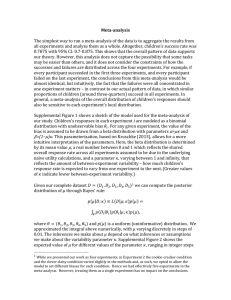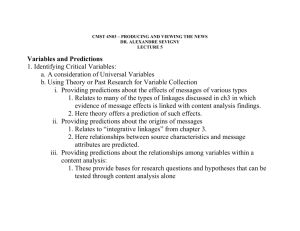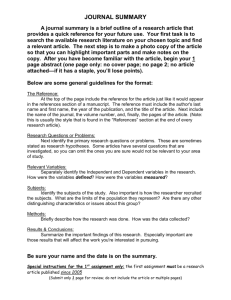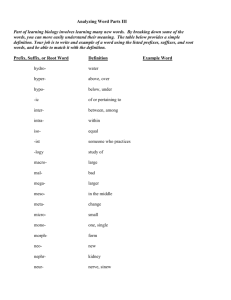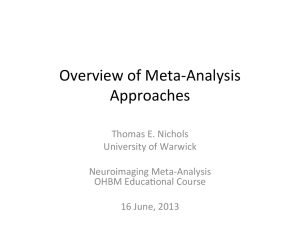Homework #1
advertisement
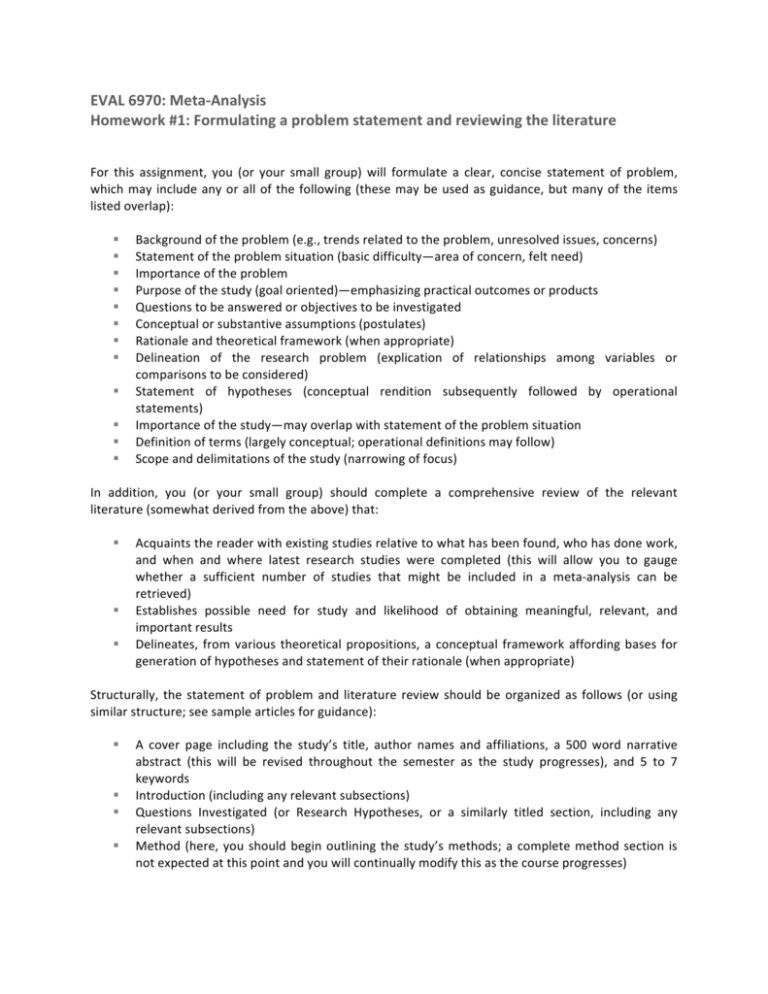
EVAL 6970: Meta-­‐Analysis Homework #1: Formulating a problem statement and reviewing the literature For this assignment, you (or your small group) will formulate a clear, concise statement of problem, which may include any or all of the following (these may be used as guidance, but many of the items listed overlap): § Background of the problem (e.g., trends related to the problem, unresolved issues, concerns) § Statement of the problem situation (basic difficulty—area of concern, felt need) § Importance of the problem § Purpose of the study (goal oriented)—emphasizing practical outcomes or products § Questions to be answered or objectives to be investigated § Conceptual or substantive assumptions (postulates) § Rationale and theoretical framework (when appropriate) § Delineation of the research problem (explication of relationships among variables or comparisons to be considered) § Statement of hypotheses (conceptual rendition subsequently followed by operational statements) § Importance of the study—may overlap with statement of the problem situation § Definition of terms (largely conceptual; operational definitions may follow) § Scope and delimitations of the study (narrowing of focus) In addition, you (or your small group) should complete a comprehensive review of the relevant literature (somewhat derived from the above) that: § Acquaints the reader with existing studies relative to what has been found, who has done work, and when and where latest research studies were completed (this will allow you to gauge whether a sufficient number of studies that might be included in a meta-­‐analysis can be retrieved) § Establishes possible need for study and likelihood of obtaining meaningful, relevant, and important results § Delineates, from various theoretical propositions, a conceptual framework affording bases for generation of hypotheses and statement of their rationale (when appropriate) Structurally, the statement of problem and literature review should be organized as follows (or using similar structure; see sample articles for guidance): § A cover page including the study’s title, author names and affiliations, a 500 word narrative abstract (this will be revised throughout the semester as the study progresses), and 5 to 7 keywords § Introduction (including any relevant subsections) § Questions Investigated (or Research Hypotheses, or a similarly titled section, including any relevant subsections) § Method (here, you should begin outlining the study’s methods; a complete method section is not expected at this point and you will continually modify this as the course progresses) § References (this section, as well as the actual literature review, must follow the style recommendations of the Publication Manual of the American Psychological Association (5th ed.) The assignment should be double-­‐spaced, using Georgia (my personal preference) or a similar font, with 5” margins, and should be written in a passive, neutral voice rather than an active, first person voice (see examples below). § “We undertook this meta-­‐analysis to investigate….” (INCORRECT) § “This meta-­‐analysis was undertaken to investigate…” (CORRECT) No page minimum or maximum is prescribed, but your literature review should be comprehensive and, to the extent feasible, exhaustive. Even so, as your study progresses throughout the semester, your introductory sections should, and will continue to, undergo revision. The assignment will be graded against the following criteria: § Clarity of problem statement (25%) § Rationale for and importance of the problem (25%) § Likelihood that the proposed problem is suitable for a meta-­‐analysis (25%) § Quality of writing (25%) For this, and future assignments, write as though the study will be submitted for publication to a peer reviewed journal.
